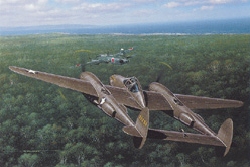|
|
| Yamamoto’s Last Flight |
|
 |

|
 |
|
|
| DESCRIPTION |
 |
| 16 x 11.5 Inch Collector Size Unframed Lithograph $40.00
On April 18, 1943, in one of the more interesting, daring, and ultimately controversial missions of WW II, a flight of P-38s under the command of Major John Mitchell, intercepted and destroyed the aircraft carrying Admiral Isoroku Yamamoto, Commander in Chief of the Japanese Combined Fleet, and the mastermind of the attack on Pearl Harbor. American code breakers had intercepted and translated a message indicating that Adm. Yamamoto would fly from Rabaul to an airfield on the southern tip of Bouganville on the morning of April 18, 1943. Because of the great distances to be covered during this intercept mission the P-38s would have very limited time over the rendezvous area. Fortunately for the Army Air Force pilots, Yamamoto was noted for his punctuality, and if he departed Rabaul on time the mission might just work. Major Mitchell led his flight of 16 P-38s to the rendezvous, with twelve of his fighters acting as high cover to fend off escorting fighters, while four pilots were designated as the “killer” flight by Mitchell and were to destroy the Mitsubishi Betty which would be carrying the Admiral. Two betty bombers and six Zero fighters were encountered. Both Bettys were downed by the killer flight and one of the four P-38s in the killer flight was lost. Unfortunately, this marvelous mission has also been surrounded by more than its share of controversy. One of the three surviving pilots of the killer flight was Thomas Lamphier. Lamphier claimed that only he fired the fatal shots into Yamamoto’s Betty. In 1972 the Air Force reviewed all relevant information surrounding the flight, including testimony from a surviving Japanese fighter pilot on the mission and a surviving passenger on the second Betty. The official Air Force decision in 1972 was that both Lamphier and his wingman Rex Barber should share equal credit. In March of 1985 another Victory Credit Board of Review was convened, and it too concluded that the victory should be shared. Later that year new evidence was out forward in the form of a taped interview with one of the surviving Zero pilots, Kenji Yanagiya. Yanagiya’s testimony clearly supported the Rex Barber account of the mission and not that of Lamphier. Lamphier, who died in 1987, continued to be outspoken until his death in his claims. In 1993, The noted aviation historian, Carroll Glines published an excellent book entitled Attack on Yamamoto. The bulk of the evidence presented in Glines book supported the conclusion that only Rex Barber probably deserves credit for the victory. More recently a board assembled by the American Fighter Aces Association met and reviewed all available facts. That Board decided that only Rex Barber deserves the official credit for downing Yamamoto. Despite all this unfortunate controversy one cannot deny that the mission to intercept Yamamoto was the longest successful mission of its type in WWII. Yamamoto’s death boosted morale in the United States, shocked the Japanese public, and was ultimately symbolic of the turn around in the War in the Pacific, which began at Midway in 1942, and gathered momentum in 1943. |
|


|